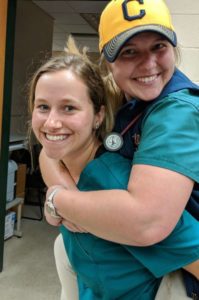I have just wrapped up my fourth week in Auburn, and it was a crazy one. On Monday, I observed three surgeries, starting with a mass removal on the ventral side on the trachea. We believe this mass formed from the cartilage cells of the trachea and fibrosis enhanced the size. The mass was successfully resected, and pathology found it to be benign. The next surgery was a sarcoid removal surgery. Sarcoids are wartlike masses found on the surface of the skin and can cause irritation. To remove the sarcoids, we resected the affected area and used electro-chemo therapy on the remaining masses. Lastly, we had emergency surgery due to a deep laceration of the left hind heal bulb. Luckily the wound did not communicate with any tendons or synovial spaces so the wound was mechanically and surgically debrided and one foreign body was found. Then vertical mattress sutures were placed along with simple interrupted to close the wound, and a cast was placed over the hoof to assist in the healing process. On Tuesday the day started with another surgery, this time we were removing a staple from a foal’s phthisis. The staple was initially placed to stunt the growth of the right side of the leg in order to correct it bowed leg. Later that day, we had a complicated tooth removal. This horse had broken tooth 209, yet only the root was left behind. In order to reach the tooth, a buccal approach was taken. Then we drilled into the tooth and pulled it out. The horse also had a sinus infection due to the broken tooth and the communication between maximal teeth and sinuses. In order to lavage, the infected sinus trephination was performed, and a drain was placed. Wednesday a tendon sheet tap was performed on a horse with enlarged hind limb metatarsal tendons. Later in the day, we had a horse come in to have a head CT. This revealed a guttural pouch mycosis that communicated with the carotid artery. The owner decided against surgery, so the horse returned home to live out its remaining days. Friday we saw a foundered pony with extremely rotated coffin bones within the hoof capsule. This horse was sent home to rest and was given pain medication; sadly, once laminitis has progressed this far, there is little that can be done. Also, this day we injected the horse with inflamed tendon sheaths. Instead of injecting steroids, we decided to do a platelet-rich plasma injection instead because it has fewer negative side effects. In order to obtain the platelet-rich plasma we took the horses blood, centra fused it down and extracted it from there. This injection uses the horses own growth factors to help heal and repair the tendon along with growth factors proteins such as aggrecan, proteoglycans, and MMP’s. The most exciting part of the week was Saturday night when an emergency neurological case came in. I voluntarily when in to observe the case. The horse was recumbent upon arrival and was unable to stand; we had to use ropes and a lot of woman power to get the horse off the trailer and into the treatment stall. Once there fluids were given to correct its hypocalcemia. The blood work showed no outstanding problems, and this case was an enigma. It was very fun to see an emergency case, and I felt like a real doctor because I got four hours of sleep that night.
In addition to my amazing week at the clinic, I had a great week in the lab as well. We are making new findings with the coefficient of friction. Such as that when we apply over 18N of force, our compressive forces switch fr0om Herztian to WInklers. This means that when the force transfers to Winkler, the force applied is having the effect ten times greater than what is to be expected. We are getting a steady flow of samples, and each time I learn something new, especially when dissecting the legs. Though I’ve been there many times, I still leave a bit queasy due to the smell of all the dead animals.
Along with the cartilage research, I was also asked to join an ileal impaction research team by Dr. Zeterstrom, a resident at the clinic. We have yet to discuss or start anything yet, but I am looking forward to it!
With the very little free time I had this week, I went out to dinner with the vet students on my rotation. The rest of my time was spent napping and doing research.


There are no comments published yet.